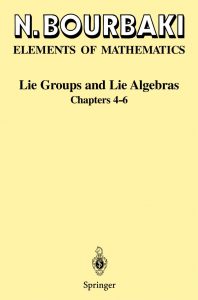 In the 1930s, a daring group of young French mathematicians, emulating Euclid’s foundational text, began the publication of a magnum opus: the Éléments de Mathématique. The aim was to provide a structured and rigorous presentation of the foundations of modern mathematics. The project had arisen from a modest intention to renew the French academic texts used for the teaching of university mathematics by two mathematicians: Henri Cartan and André Weil. From there, the project gained depth and ambition, as the number of participants grew and the collective process of discussion and writing was enriched. Eventually, the group assumed the (fictitious) name of Nicolas Bourbaki, under which its publications appeared. These were characterised by the fact that they were more a reference for research activity than a teaching text. They adhered to the strictest axiomatic method: “The axiomatic method teaches to look for the deep reasons (…) buried under the accumulation of details specific to each one of them”. They were animated by an intense urge to bring the structure of mathematics to the surface, giving it a central role in mathematics. This intention generated a strong support as well as an intense rejection.
In the 1930s, a daring group of young French mathematicians, emulating Euclid’s foundational text, began the publication of a magnum opus: the Éléments de Mathématique. The aim was to provide a structured and rigorous presentation of the foundations of modern mathematics. The project had arisen from a modest intention to renew the French academic texts used for the teaching of university mathematics by two mathematicians: Henri Cartan and André Weil. From there, the project gained depth and ambition, as the number of participants grew and the collective process of discussion and writing was enriched. Eventually, the group assumed the (fictitious) name of Nicolas Bourbaki, under which its publications appeared. These were characterised by the fact that they were more a reference for research activity than a teaching text. They adhered to the strictest axiomatic method: “The axiomatic method teaches to look for the deep reasons (…) buried under the accumulation of details specific to each one of them”. They were animated by an intense urge to bring the structure of mathematics to the surface, giving it a central role in mathematics. This intention generated a strong support as well as an intense rejection.
This very brief outline of the Bourbaki group serves to set the context of the 1970 International Congress of Mathematicians (ICM) in Nice. Until that year, the mathematics presented at the ICMs was organised according to a simple classification by sections.
At the first ICM, held in Zurich in 1897, there were five sections:
- Arithmetic and Algebra
- Analysis and Theory of Functions
- Geometry
- Mechanics and physics-mathematics
- History and bibliography
At subsequent congresses (Paris, 1900; Heidelberg, 1904; Rome, 1908; Cambridge, 1912; Strasbourg, 1920; Toronto, 1924; Bologna, 1928; Zurich, 1932; Oslo, 1936; Cambridge, MA, 1950; Amsterdam, 1954; Edinburgh, 1958; Stockholm, 1962) these sections were essentially maintained. There was, however, some renaming, some grouping or subdivision, and the inclusion of applied mathematics, probability, philosophy and logic, and didactics.
The next congress was held in Moscow in 1966, with a record number of participants, some 4,200, and a significant growth in the number of sessions:
- Mathematical logic and Foundations of Mathematics
- Algebra
- Number theory
- Classical analysis
- Functional analysis
- Ordinary Differential Equations
- Partial Differential Equations
- Topology
- Geometry
- Algebraic geometry and complex varieties
- Probability theory and statistics
- Applied mathematics and physics-mathematics
- Mathematical problems of control theory
- Numerical mathematics
- Historical and pedagogical issues
This extensive list was an attempt to embrace a mathematical research reality that was clearly expanding.
The 1970 congress was held in Nice, and was organised by relevant members of the Bourbaki group. It was the opportunity to make a public presentation, beyond publications, of their structured vision of mathematics. In contrast to the linear list of sections at the Moscow congress, in Nice there were 34 sections, grouped into six major groups:
- (A) Mathematical Logic
- (B) Algebra, with 6 subsections
- (C) Geometry and Topology, with 5 subsections
- (D) Analysis, with 12 subsections
- (E) Applied Mathematics, with 8 subsections
- (F) History and Teaching, with 2 subsections
As an example, section (D) on Analysis was subdivided as follows:
- D1. Topological vector spaces
- D2. Operator algebras; representation of locally compact groups
- D3. Spectral theory
- D4. Algebras of functions; Fourier analysis
- D5. Potential theory; Markov processes
- D6. Probability, measure theory, integration
- D7. Analytic functions of a complex variable
- D8. Complex analytic functions and spaces
- D9. Exceptional sets in analysis
- D10. Functional analysis and linear partial derivative equations.
- D11. Functional analysis and equations in non-linear partial derivatives
- D12. Dynamical systems and ordinary differential equations
The Bourbaki experiment did not succeed, the general opinion was not in favour of such excessive structuring. From the next congress (Vancouver, 1974) onwards, the simple linear structure was returned to. At present there are 19 sections in linear order in the ICMs.
Bibliography
Bourbaki, N., The Architecture of Mathematics, The American Mathematical Monthly, 57 (1950), 221-232.
Curbera, G. P., Mathematicians of the World; Unite! The International Congress of Mathematicians, a Human Endeavour. AK Peters, Wellesley, MA, 2009.
This book is publicly available on the website of the International Mathematical Union:
https://www.mathunion.org/fileadmin/ICM/Others/Mathematician_of_World_Unite-T_and_F.pdf

Leave a Reply